#📗coolthingcompilation
Text

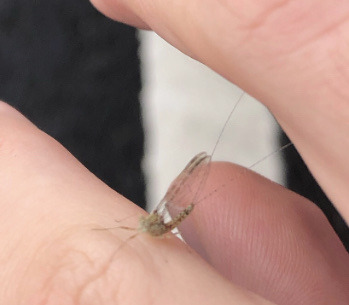
Little mayfly that sat on me for a while. What a nice guy! I’ve probably seen mayflies before but I didn’t know what they were, this was the first time I was really aware of em’, let me tell you I went DGDVDVDCmayflyFBDJSVD
9 notes
·
View notes
Text

Bloody dogwood (Cornus sanguinea) flowers! This shrub is also called "Midwinter fire"... such a poetic name, don't you think[I'm totally naming my vampire love novel this]? It's called that because of the red color of its branches which get to show off after the leaves leave :P Obviously, this guy is pretty famous as an ornamental plant! Note that the younger the branch the redder it is!
#my photgraphy#📗coolthingcompilation#plant#tree#shrub#flowers#photography#bloody dogwood#common dogwood#biology#greenery#foliage#peaceful#trees#nature
12 notes
·
View notes
Note
1, 20 (for the bug asks)
20. what's a random bug fact that you tell people whenever bugs come up in conversation?
This depends with who I'm talking to, but with the non-insect lovers(not haters, just not lover ig):
"So, did you know cockroaches eat keratin? Guess who's keeping your hair from growing longer faster ;>"

1.what's your favorite bug?
So I can't pick, I'll split this question into 5 categories I guess, so here's some guys I find cool:
1> Fave Parasitic guy(s): Strepsiptera (Order)
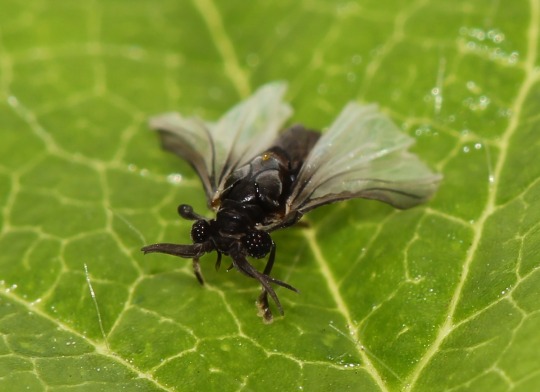
2> Prettiest: Rainbow Grasshopper (Dactylotum bicolor)
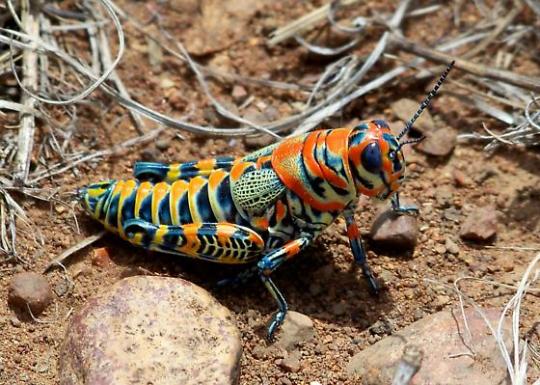
one of many "art inspo" critters
3> Guy who's (un)popular with the elderly but I would fight for: Mole cricket(Gryllotalpa gryllotalpa)

He may ruin the crops... but,,, but he's just some guy c'mon!! (plus they look like lobsters and I love lobsters)
4> All around amazing: Pied Lacewing (Porismus strigatus)

5> Better as larva (sorry):Trichoptera (Order)

The adults are basically discount moths so....
#ty for the ask!! just having fun with insects#🦞chat#insect#bug#caddisfly#lacewing#neuroptera#trichoptera#orthoptera#mole cricket#parasitism#shitpost#I mean. Gregloria Samsa#cockroach#mailbox✉️#📗coolthingcompilation
6 notes
·
View notes
Text
*Fire opening sequence*
Hell-oh, the name's Theo, but I prefer Cheeziwz! •He/They
Art Archive (in theory, I should post my art here and rb it there but I have yet to migrate everything there...): @crustychipset
Just trying to have a good and make friends with similar interests, Gaga bless the interwebz for this opportunity! I post art sometimes[mostly sketches and doodles but finished art too sometimes...], lots of photos usually of insects, nature, eastern european trash and whatever gets me WOWing like a child. Scott the Woz and Lady Gaga fan, hopefully I'm not the only one in this Wenn Diagram.
I also reblog a ton, just so you know.
If you follow me and I follow you back, no, I don’t do follow for follow, I just think you’re cool🕶
My tags: •📗coolthingcompilation (ramble about biology/nature) •cheez scribbles stuff (my art) •🦞chat (just ramble, like a diary, cringe) •oc
Games(I think about a lot): Terraria, RoR2, NIER, Skyrim, Psychonauts and Mario&Luigi games
Asks and DMs always open, ramble to me and I'll ramble to you.
Oh and, be warned, I'm trying to speedrun being the cool gay uncle so I make a lot of terrible jokes. And I talk too much. :P
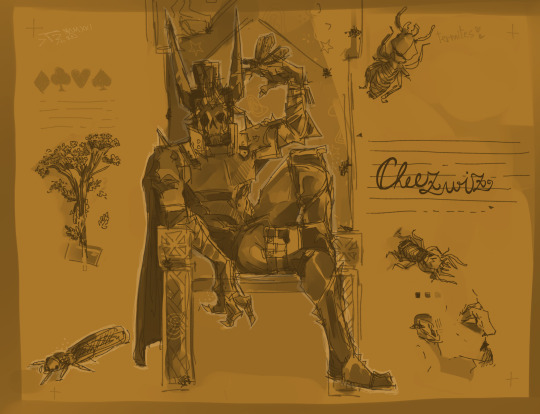
7 notes
·
View notes
Text
Moths. Feathers. Moths with feathers*!!
*These feathers are brought to you by CONVERGENT EVOLUTION!
So, here's the Alucitidae Family!! Commonly known as the many-plumed moths!! (Note, there’s also just plume moths, in the Pterophoridae family, but I wanted to talk about these ones today)
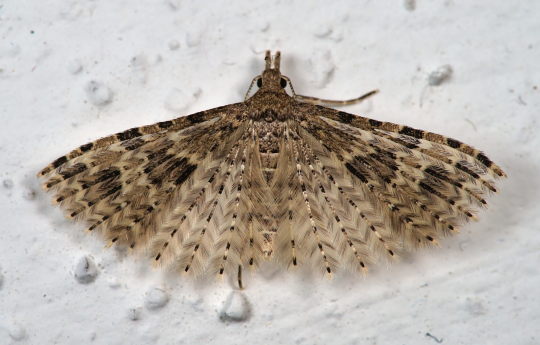
Their wings are really something else! Each wing is made up of about 6 flexible spines from which bristles (similar to the barbs of bird feathers) project laterally forming feathers! There are about 200 species known, they are pretty small, the wingspan of adults ranging from 7-28mm. They are distributed in temperate and subtropical regions worldwide and, not surprisingly, are mostly nocturnal and some crepuscular. Their larvae tunnel through the leaves and buds of various shrubs, the larvae of the type species for example, Alucita hexadactyla (pictured above as adult, as larva below), feeds on honeysuckle!
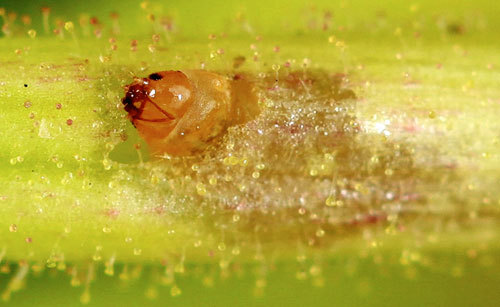
Also as a little fun fact, until 2004 there was only one species of many-plumed moth known to live in North America, A. montana (lowest photo) which was by the way mistaken to be the same as the European type species I talked above, since then however, two more species have been discovered by Bernard and Jean-François Landry, A. adriendenisi (left) and A. lalannei (right)!
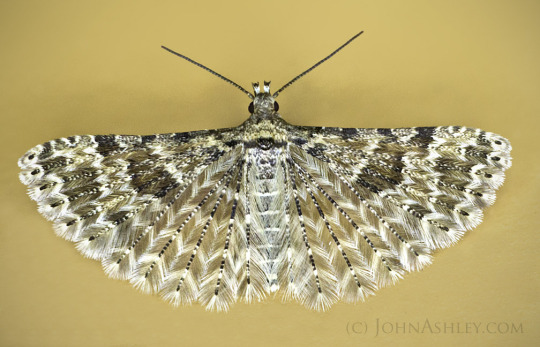


Mothman's fashionable brother.
#insect#moth#lepidoptera#bugblr#arthropod#zoology#fun facts#📗coolthingcompilation#infodump#tw insects#entomology#biology#many-plume moth#nature
7K notes
·
View notes
Text
Neuropterans time!!

They are slowly but surely climbing to the title of my favourite insect order!
So yeah, let me tell you some stuff about them! And today I’ll mostly focus on antlions because they are really cool (and by that I mean their larvae)!
So, to get a sense of these guys, neuroptera is an insect order comprising of about 6000 species, they include antlions, lacewings, spoonwings, mantidflies etc, and are closely related to snakeflies and alderflies. As generalities go, they have four iconic venated wings. Their larvae are especially interesting as they are fierce predators, I’ll discuss it a bit later. Also, are holometabolous (they pupate).
They have first appeared during the Permian and have diversified trough the Mesozoic Era! A notable extinct family is the Kalligrommatidae which are also know as the “Butterflies of the Jurrasic” because:
1. They filled the same ecological niche (had a proboscis with which they fed on plant juices and pollen)
2. They had quite big and ornate wings that had also developed scales (not seen in modern neuropterans) Now about Antlions (Family Myrmeleontidae)
Below: wing of an antlion in the Makarkinia genus of the Kalligrommatidae family. The insects of this family had the biggest wingspans of all, with the largest being about 160 mms, while in extant antlions the biggest wingspans belong to the genus Palpares.
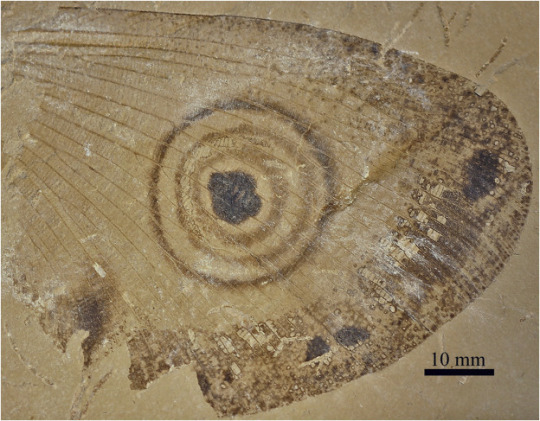
Below: Palpares libelluloides (100mm wingspan, are found across Southern Europe)

Now about Antlions (Family Myrmeleontidae)
They are especially known for their predatory larvae, adults are more rarely encountered as they have short lifespans, around 25 days, at most 45 days in some species (do not feed, just reproduce) and on top of that are active at dusk and night. Although they have a worldwide distribution they prefer hotter, sandy places.
Now about the larvae which are basically THE highlight of the species:
While generally being half an inch, the larvae are one of the fiercest insect predators. In many of the species the larva dig special funnel-shaped traps in the sand using their heads. They then slightly burrow themselves in the middle and wait for other insects (mostly ants) to fall down the steep walls of the trap. They then use their sickle-like jaws to grasp the prey and they inject it with paralysing venom and digestive enzymes and afterwards they suck their insides then throw the husk out of the trap and get ready for the next meal. They stay in larva form even for years, they prepare for metamorphosis when they have reached a certain size.
Below: Antlion it its trap:

Also, note that not all larvae of the species make traps like such, some just hide in leaves, bark etc, and an interesting case would be that of the Dendroleon jezoensis species which spends its time on rocks, covering itself with lichen for hunting camouflage! (below)

Also, more cool facts about the antlions:
They can surive for moths without food as they have a slow metabolic rate (since ya know, they gotta' wait for their food, good adaptation guys)
Antlions hold the record of biggest size disparity between larva and adult. The adults, while not feeding, are bigger because of their low internal density. (Adults are actually quite flimsy and not very good fliers, and uh, not to mention the fact that the larvae EAT THEIR OWN ADULTS SOMETIMES :,,,, so uh, when the adult females come to deposit their eggs, they come and tap the soil a few times with their ovipositor and sometimes uh, surprise they could become meal for the children... nature)
In America antlions are known as doodlebugs because when the larvae relocate they leave these tunnels in the ground:
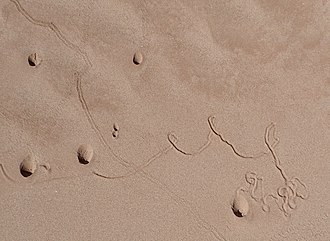
Euroleon nostras below
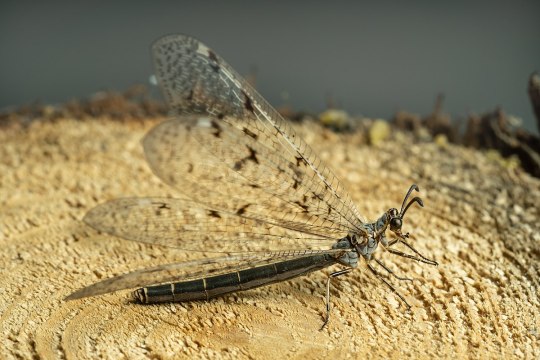
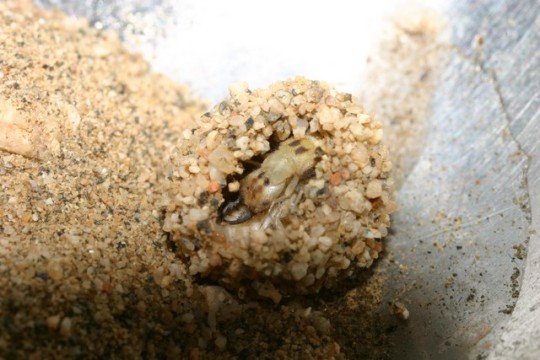
Also, above, the miracle of life, pupation!
Ok, maybe this is it for now, love these guys so much, they are very cute, OH BUT ALSO, their names comes from some weird mythical Christian creature called Myrmecoleon but I won't get into that, it's 1 AM... OH OH, but they are also in Terraria :O

No. Today I felt evil and did not put anything under READMORE because I want people to witness these insects! And ah, fact check me pls, I'm so sleepy and kinda looney.
#why do I start rambling before bed#this is the goodnight post#Should I double read this?? idk I'll try. I'll have Maneater blasting in my ears to keep me awake.#sketch#doodle#insect#neuroptera#myrmeleontidae#antlions#antlion#bug#animal#bugblr#informartion#infodump#the more you know#art#biology#📗coolthingcompilation#insect facts#arthropods#I missed using tumblr like this#lacewings make me explode/pos#paleo
360 notes
·
View notes
Text
A COMPILATION OF JOY [ANIMALS]
Volume 1. I’m tired and bored. But they brought me joy so I thought I should share.
•just me saying random stuff because this is my blog and I can!•

This calico lobster. I was about to call it palico (thank you Monster Hunter <3). Well, he’s got one of my favourite color palletes, spells danger.
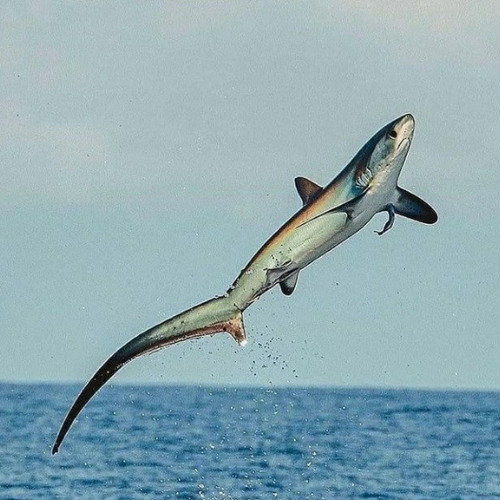

The Lovers

This ice crawler. He’s just having a chill time, just vibing, just walking, just…

He. He’s everything. That smile, that sweet, innocent smile. I know he has seen things, he sure has, but despite that, he keeps smiling and that… makes me smile too! A bowtie is what he needs, and a hug. Or it is I who needs a hug from him?
Hits post
89 notes
·
View notes
Text
TRICHOPTERA TIME! ______________________________
Caddisflies(Order Trichoptera, trichos=hair, ptera=wing... because they have bristly wings)!! I'll keep it short for adults, larvae are the highlight mwheheh.
Let’s get the adults out of the way. They have hairy wings that slightly resemble the scaly wings of moths and they are in fact related to lepidopterans (are more primitive than them).
These guys can be found worldwide near bodies of water (they need do lay their eggs on plants that will get submerged in water or straight up in the water) with greater species diversity in the warmer regions. The adults usually live for just a few weeks, most don’t feed, yet some species can feed on nectar (ex:Tinodes waeneri). They mate and bye.
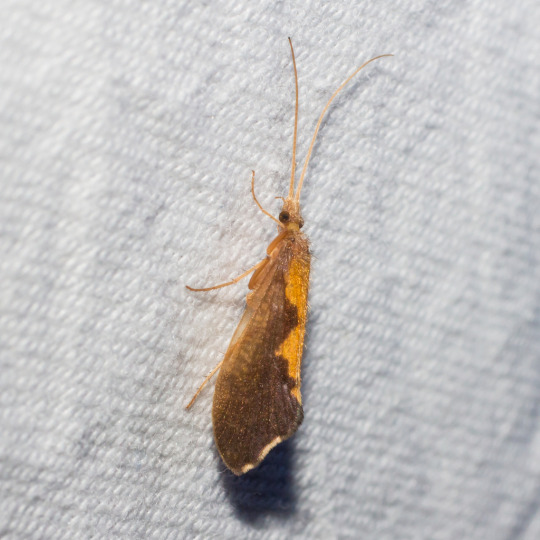
Neophylax sp. adult. Also called Autumn mottled sedges! X
Now, with adults out of the way, time to talk about the larvae, which are what made me super intrigued. First off, they are aquatic, six pairs of gills on the abdomen, most species are freshwater with very few brackish coastal water oddities (Fun fact, Philanisus plebeius eggs have been found in laid starfish). The larvae are kinda similar in looks to butterfly caterpillars (yes yes, as I said, their closely related to Lepidopterans) but they lack the prolegs (those many temporary legs that will disappear once the larva becomes an adult).
_________________________________________________
Enough with the looks, now about their diet. The diet differs from species to species, most are detrivores, some shredder-herbivores (chew on live plants) and some are even predators!! Also funnest of facts, a species originally though to be herbivorous was found eating meat off of deer bones!

Gumaga nigricula and carcasses, paper here X
Yeah, some are opportunistic feeders, eating dead fish and whatever else died!
… I do not know how to properly link the paragraphs, as you can tell heheh…
Ok. The coolest trait time!! THEY ARE ARCHITECTS, DESIGNERS, SURVIVORS and what I mean by that is that larvae build different structures with various purposes (protection and feeding mostly) with the most well know of all being their cases!
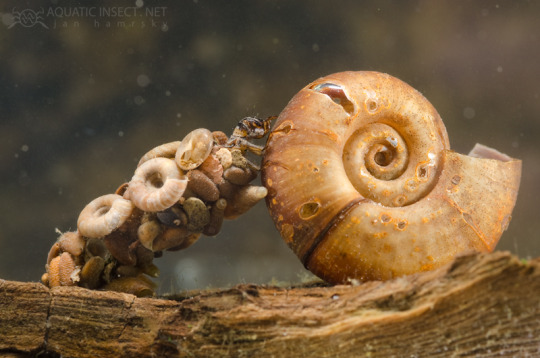
Limnephilus flavicornis with a shell case X
They build these cases out of debris, plant bits, gravel and even shells!! These cases are open at both ends (so water can pass trough and wash the larva’s gills) and they get enlarged manually by the insect with every growth, so yeah, they don’t really change their case, commitment to their craft, I love that… oh and not to mention the “blueprints” for these houses are genetically hardwired in the insects, so the same individuals of a species would have similar looking cases (materials chosen and structure) but different from members of other species (this applies as far as I’m concerned at a genus level) so it makes identifying easier only by looking at the cases! Now these cases are so convenient, some caddisflies don’t even have to move around (members of the Annulipalpia suborder), they lazily wait for food to come to them (ok, I admit, they put in some more effort and spun some silk nets but still), while some move around (members of the Integripalpia), actively searching for food while carrying around their little houses.
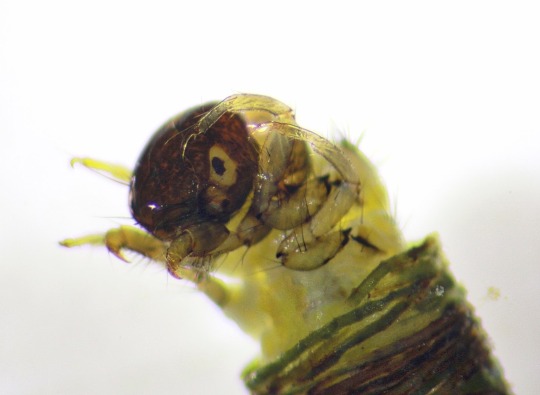
(Integripalpia) Micrasema wataga X

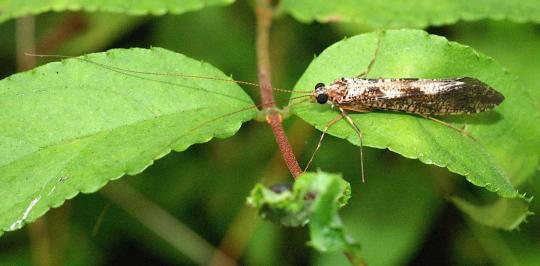
(Annulipalpia) Stenopsyche sp. X X
Oh but that’s not all! Some caddisflies (some members of the Spicipalpia suborder, and some Annulipalpians, example: Hydropsychidae family) only make a case before pupation, so in their final larval instar. During their childhood, instead of making cases like the other kids, they spun dome shaped enclosures out of silk, usually on the surfaces of rocks, in which they trap detritus and “culture” periphyte (a complex of underwater algae, cyanobacteria, microbes etc… ).

Net spinning caddisfly, in the Hydropsychidae superfamily _________________________________________________
Also note that the larvae of the Rhyacophilidae family are free living predators, they do not build cases, nor spin nets. They also appear to be the most primitive forms of caddisflies, having the earliest evidence in the fossil record (known from the Mesozoic).
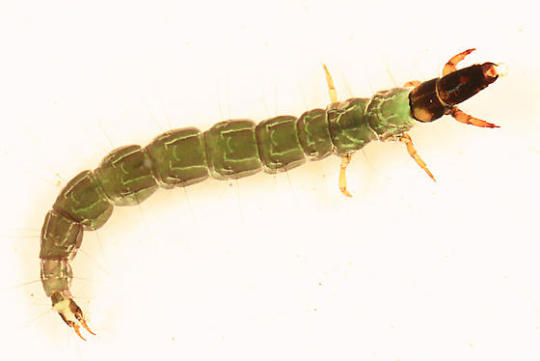
Rhyacophila acutiloba
AAAND, apparently they are using the talented caddisflies to make jewelry...

Could have written some more stuff on this post but it's waaay too long...I'll add this article on the dangers that microplastics pose to the case-building caddisfly larvae however.
#if u have any correvtions or stuff to add pls!!!#hope more people get interested in these guys!#insect#tw bugs#tw insects#trichoptera#bugblr#📗coolthingcompilation#infodump#biology#my bio notes#aquatic#aquatic biology#fun fact#fun facts#nature#bug#caddisfly#curiosity#cute#because they are#zoology#entomology
83 notes
·
View notes
Text
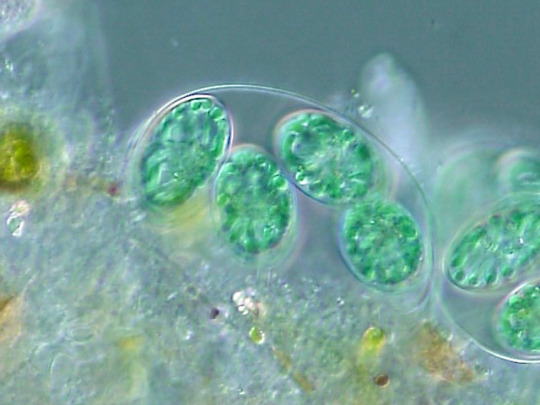
Random Bio Notes:
Ooh, so, I found out glaucophytes are a thing while reading about algae and stuff. And AH, I’m so amazed :O
So they are a small group (wiki says 15 have been described so far) of unicellular algae that are thought to be the most basal of algae and are studied by biologists because they may hold the secrets of the chloroplast endosymbiotic origin theory! Idk, I think it’s just really cool, their plastids are called cyanoplasts since they are even more similar to cyanobacteria[since that’s basically what they are](they have kept their peptidoglycan layer, a characteristic bacterial component!) than the true chloroplasts. Idk, I just think evolution’s so cool and wanted to share this just because.
If there’s one(2) thing(s) I love, that would be Biology and videogame Beta versions, and these algae feel exactly like … YEAH!
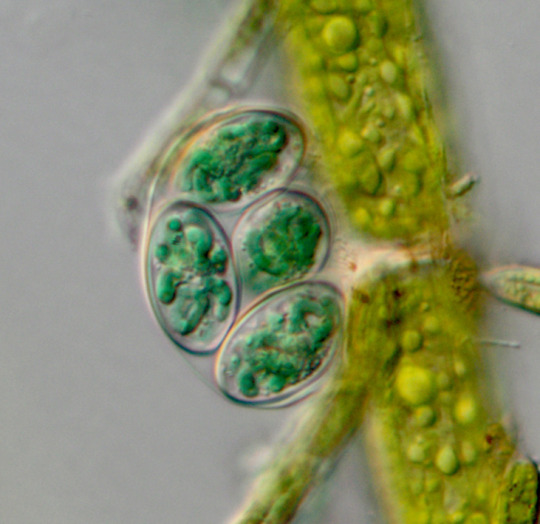
#biology#📗coolthingcompilation#🦞chat#science#algae#my bio notes#maybe making a new bio note tag. i actually could share so many fun notes and stuff for whos interested in random cool biology stuff#like. it would be fun for this to be kind of a study blog or something like that.#idk idk. I have many microbes on my brain currently
83 notes
·
View notes
Text
This one shrimp again, being amazing.
112 notes
·
View notes
Text
This is a good night post! But also, a post dedicated to the giant river prawn!! (Macrobrachium rosenbergii)
What’s cool about them? Well, glad you asked!
The sexually mature males come in three different major morphotypes depending on their position in a structured hierarchy (they fight for these positions in different ways depending on their forms too!)
The three major morphotypes are:
Blue Claw (BC) These guys are at the top. The strongest, agressive and territorial and very successful to mate! However they grow very slowly but are pretty big!⬇️
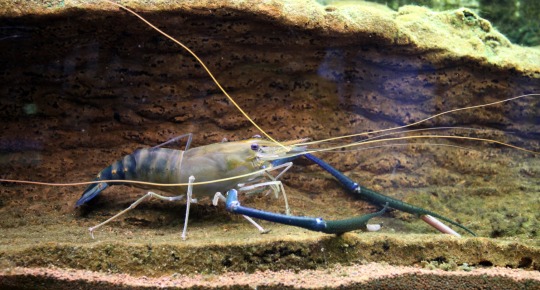
Orange Claws (OC). They are smaller, however can grow really fast and can reach the size of a BC which will then fight to attain a BC form themselves! They are less likely to mate and are less agressive. (Shorter claws than BC males) ⬇️

Finally, the last major morphotype and weakest but loveable!
The Small Male (SM)! They are smaller of course, all prawn start from here. Their growth is inhibited by the BCs (basically they don’t grow because they get T posed on). They are not territorial and have small transparent claws. They have their own mating strategy however, a sneak mating! They are small and agile and will try to mate, with females *sneakily*. BCs are the ones that are popular and get to mate, they do protect the females since they are the strongest so it is fair I guess, but SMs will try anyway and sometimes succed!

These are them!
Ok, but really, good night for now! Tired tired :D
#giant river prawn#giant freshwater shrimp#GOOD NIGHT !!#i hope I didn’t make mistakes or sth because I am really tired#it is midnight#almost#prawn#shrimp#biology#animal#🦞chat#📗coolthingcompilation#<tag for my little fact thingies!!#if I’ll make more#marine biology#limnology
107 notes
·
View notes
Text
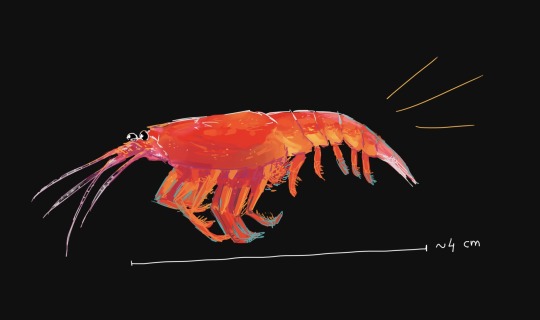
This is the morning doodle post! Good morning!
Here’s a bentheuphausia ambylops! The most primitive krill of them all! These guys are not bioluminescent unlike all other krills, but they are still pretty nice, and can be found in the depths of many of the worlds oceans, below 1000 meters!
#yep yep yep#krill#benthuphausia#ok I’m sure I’ve mispelled this guy#he’s really nice#📗coolthingcompilation#doodle#digitalart#did this late night yesterday but I wanted to post it now#sorry for no new finished art in a long while this is still just a doodle#crustaceans#marine biology#biology#it looks kinda inaccurate btw oof#cheez scibbles stuff
91 notes
·
View notes
Text
Photo and 12 AM ramble time!

Just a bunch of photos of soldier beetles (Cantharis sp. , if I were to choose an exact species I would say this is C. rustica!) I took today!


Let me tell you, I was so excited to see these guys! These were all taken in the same grass patch at different times. During later morning a bunch started crawling out of the grass and climbing on top! Watched them fly around for a little, also it's exceptionally cute when they follow you around, this one dude flew on top of a leaf and would follow my every movement haha. Closer to sundown I found some guys mating, wasn't very polite of me but I had to take some photos.

Also, we call this little guy "doctorașul" which translates to "little doctor"(it’s actually such a sweet word, translating it into english doesn’t really do it justice… maybe there’s a better word…), I do not know why, maybe it's the little heart mark on the pronotum or sth. Speaking of the heart mark, it's LOVEly!

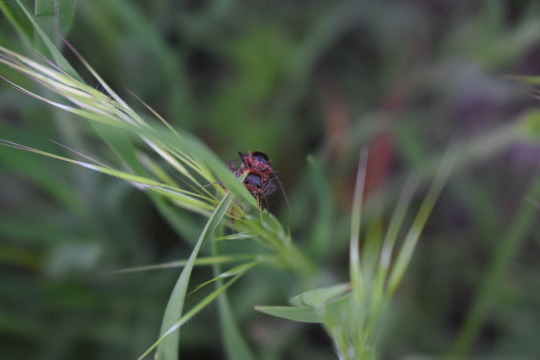
Huh, not much else to say, they really made my day! Been fighting that annoying anxiety again, they really made things easier :3 Some days everything feels like a challenge, it’s on those days that the joy little things bring is truly apparent. Grateful for that heh
Got some more insects and some birds too but there's so many photos a Tumblr post can take oouf + I’m tired and afraid I’ll typo to death.
#sorry for any typos!!!#🦞chat#the good night post#insect#beetle#coleoptera#photography#insect photography#cantharis#soldier beetle#positivity#literally just a ramble hahaha#nature#insect hunt#📗coolthingcompilation
18 notes
·
View notes
Text

Some info I gathered about the ram’s horn squid (Spirula spirula)!
This little cephalopod is the only species left of it’s genus and is one of the oldest squid-like cephalopods still alive, they have diverged from a common ancestor that they shared with squids, cuttlefish and octopuses (yeah, we call it a squid but it is not exactly, same can be said about bobtail squids lol). It lives at depths of 500-1000m, and migrates at night in shallower waters to feed! It is quite small, between 35mm-45mm, and a cool thing about it is that inside the mantle it has a shell that it uses as a buoyancy organ, similar to nautili, this however is a little different as the coils do not touch and the siphuncle is marginal.
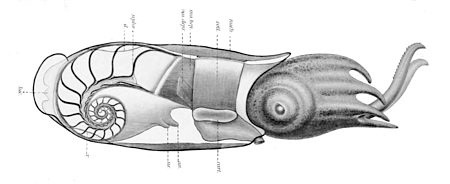
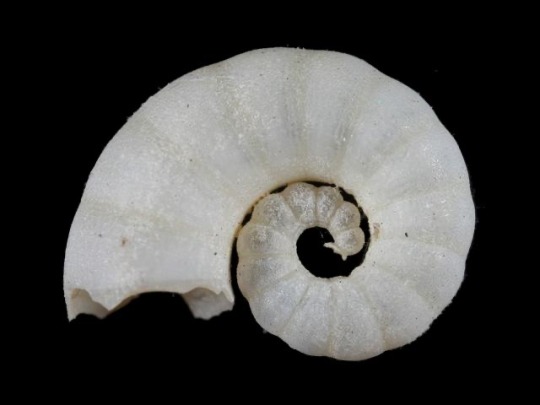
This little thing also has a photophore that emmits green light and is thought to be used for counter-illumination. They are rarely encountered alive (with one being observed in its natural habitat for the first time in 2020!!), but their shells are commonly found on beaches (especially tropical) on which they arrive carried the waves (the shells are very buoyant).
#also the good night post!#I probably done some bad wording as usual. maybe I shouldn’t write these before going to bed??#📗coolthingcompilation#marine biology#cephalopod#cephalopods#ram’s horn squid#marine life#animal#infodump#biology#squid#Ah
73 notes
·
View notes
Text
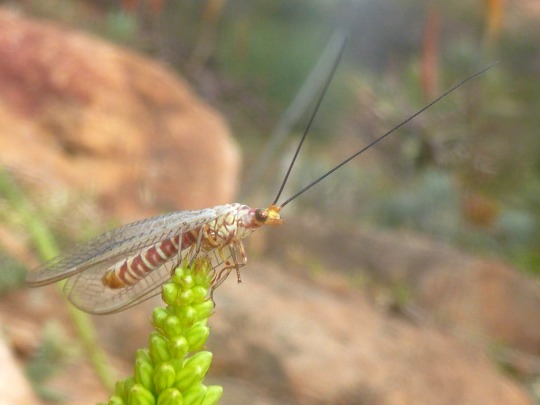
NEUROPTERA MOMENT 2 (Dysochrysa furcata above)
Family Chrysopidae - Green Lacewings
There are about ~1200 species of green lacewings distributed worldwide. The adults of most species are green with golden eyes. They have four venated approximately equal wings!
They have a wingspan ranging 6 to over 65mm (the bigger species are tropical). Lacewings of the Chrysopa genus are sometimes known as "stinkflies" because of their ability to produce a vile smell with a special gland.
Chrysopa nigricornis below
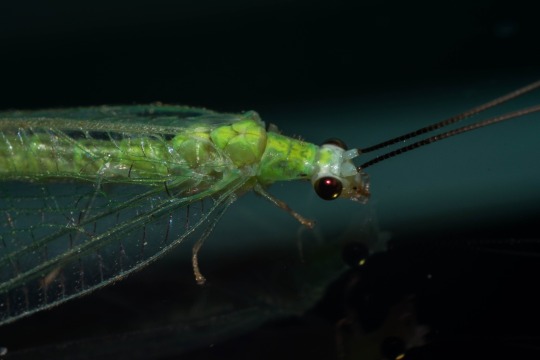
Adults are crepuscular or nocturnal and they feed on pollen and nectar but also aphids and mites, with some species being fully predatory like the lacewings of the Chrysopa genus.
Cool little fact: Adults that feed only on plant substances have special symbiotic bacteria inside some of their trachea that provide them with essential nutrients defficient from their diet.
They are usually found flying near grasses and shrubs and are especially attracted by flowers like cosmos, sunflowers, dandelions etc.
Lacewings have two different modes of hearing.
1. They have a tympanal organ at the base of each forewing which can even sense ultrasonic sounds. When they detect the low ultrasound calls of bats they cease flight and drop and while the bat appraoches, as its call's frequency increases, the lacewings takes it as signal to open it's wings an flap away quickly in an escape manouevre
2. They can also perceive low-frequency vibrations in the ground with special organs located inside their legs. During mating they produce different "courtship tremors" with their abdomen, therefore this type of hearing is important in reproduction. Songs are also species specific!!!
Chrysoperla lucasina (below)

The larvae are… of course… very fierce predators and also called “aphid lions”. They feed on other small insects, especially aphids and caterpillars and they don’t discriminate so they’ll feed on eachother too (thankfully, since their eggs are layed by females on hanging stalks they are out of reach from the hungry grasp of the newborns, so the still unhatched eggs are safe for a while).
A larva:

The larvae have weak senses, so they walk in a weird random manner and sway their heads from side to side hoping to bump into a possible meal, and when they hit anything, they grab it with their maxillae. They inject their prey with digestive enzymes and paralysing venom and can apparently dissolve the organs of aphids in about 90 seconds. Wild. Oh and of course, then they suck yum yum with their hollow maxillae! Afterwards, some use the remnants of their meal (the integuments of aphids mostly) to camouflage themselves and to detter predators!
Below: A larva camouflaging itself by carrying various debris
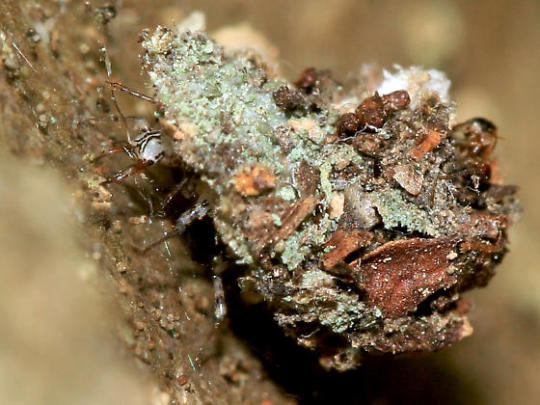
If they feed continuously for about two weeks they are ready to spin a cuccon in which they sit for about two weeks (some species overwinter however so they can sit inside for longer). Adults are short lived, about 4-6 weeks, but this needs checking.
Nothochrysa californica (below)

Also, green lacewings are often used in pest control!
That's it for now, it's almost 1:30AM something is wrong with me. No time to fact check rn fr
#insects#insect#this is the goodnight post#📗coolthingcompilation#insectblr#bugblr#neuroptera#green lacewing#the more you know#insect facts#biology#entomology#chrysopidae#net-wingged insects#infodump#notes#animals#animal#CUTE CUTE CUTE#lady gaga is keeping me so alive rn#I said I'll go eat a sandwich an hour ago but I fell in the rabbithole
13 notes
·
View notes
Text
So I was doing a little research on woodlice as I want to make a closed terrarium soon and I need to add some of them too, and came across some cool information, but as a highlight, here we have:
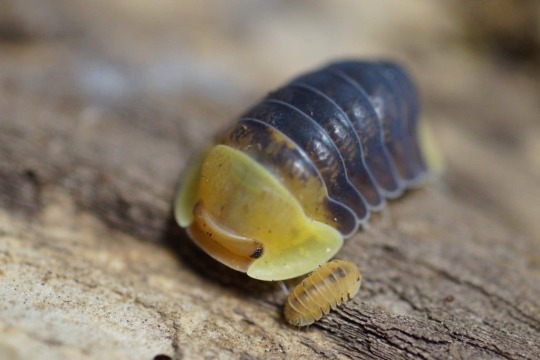
The Rubber Ducky! It’s actually a whole genus called Cubaris! These are so cute, but I’ve read they are a little expensive as they are slow to breed and have higher lifespans and are pretty rare too!

And also I’ve read about the invertebrate iridescent virus 31 (IIV-31) which makes the woodlice appear blue due to it’s arrangement in the animal’s tissues. Altough not good for them(decreases responsiveness and increases mortality), the look they get is pretty unique so it caught my attention, and also the fact that this virus might have been potentially identified in a species trapped in an amber from the early cretaceous is quite WOW!
#once again. apologies for the bad wording uh#I love isopods#isopods#woodlice#bugs#crustaceans#📗coolthingcompilation#animal facts
24 notes
·
View notes